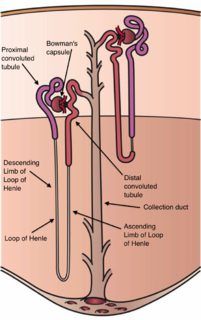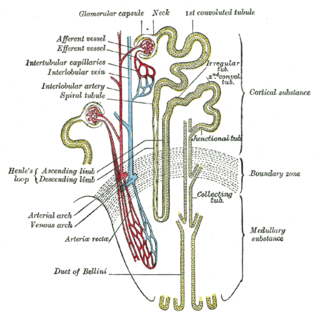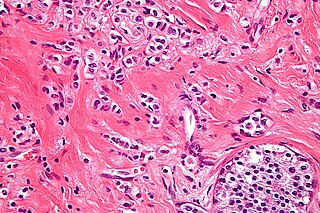
The nephron is the microscopic structural and functional unit of the kidney. It is composed of a renal corpuscle and a renal tubule. The renal corpuscle consists of a tuft of capillaries called a glomerulus and an encompassing Bowman's capsule. The renal tubule extends from the capsule. The capsule and tubule are connected and are composed of epithelial cells with a lumen. A healthy adult has 0.8 to 1.5 million nephrons in each kidney. Blood is filtered as it passes through three layers: the endothelial cells of the capillary wall, its basement membrane, and between the foot processes of the podocytes of the lining of the capsule. The tubule has adjacent peritubular capillaries that run between the descending and ascending portions of the tubule. As the fluid from the capsule flows down into the tubule, it is processed by the epithelial cells lining the tubule: water is reabsorbed and substances are exchanged ; first with the interstitial fluid outside the tubules, and then into the plasma in the adjacent peritubular capillaries through the endothelial cells lining that capillary. This process regulates the volume of body fluid as well as levels of many body substances. At the end of the tubule, the remaining fluid—urine—exits: it is composed of water, metabolic waste, and toxins.

The collecting duct system of the kidney consists of a series of tubules and ducts that physically connect nephrons to a minor calyx or directly to the renal pelvis. The collecting duct system participates in electrolyte and fluid balance through reabsorption and excretion, processes regulated by the hormones aldosterone and vasopressin.

Papillary (collecting) ducts are anatomical structures of the kidneys, previously known as the ducts of Bellini. Papillary ducts represent the most distal portion of the collecting duct. They receive renal filtrate from several medullary collecting ducts and empty into a minor calyx. Papillary ducts continue the work of water reabsorption and electrolyte balance initiated in the collecting tubules.
Invasive carcinoma of no special type (NST) also known as invasive ductal carcinoma or ductal NOS and previously known as invasive ductal carcinoma, not otherwise specified (NOS) is a group of breast cancers that do not have the "specific differentiating features". Those that have these features belong to other types.

Centroacinar cells are spindle-shaped cells in the exocrine pancreas. Centroacinar cells are an extension of the intercalated duct cells into each pancreatic acinus. The intercalated ducts take the bicarbonate to intralobular ducts which become lobular ducts. These lobular ducts finally converge to form the main pancreatic duct.
A cortical lobule is a part of a renal lobe. It consists of the nephrons grouped around a single medullary ray, and draining into a single collecting duct. Its near identical parallel is the rectal lobe, which is present in the majority of mammals.

Congenital hepatic fibrosis is an inherited fibrocystic liver disease associated with proliferation of interlobular bile ducts within the portal areas and fibrosis that do not alter hepatic lobular architecture. The fibrosis would affect resistance in portal veins leading to portal hypertension.

Medullary sponge kidney is a congenital disorder of the kidneys characterized by cystic dilatation of the collecting tubules in one or both kidneys. Individuals with medullary sponge kidney are at increased risk for kidney stones and urinary tract infection (UTI). Patients with MSK typically pass twice as many stones per year as do other stone formers without MSK. While described as a "benign" disorder with a low morbidity rate, as many as 10% of patients with MSK have an increased risk of morbidity associated with frequent stones and UTIs. While some patients report increased chronic kidney pain, the source of the pain, when a UTI or blockage is not present, is unclear at this time. Renal colic is present in 55% of patients. Women with MSK experience more stones, UTIs, and complications than men. MSK was previously believed not to be hereditary but there is more evidence coming forth that may indicate otherwise.
Atypical hyperplasia is a benign (noncancerous) cellular hyperplasia in which cells show some atypia. In this condition, cells look abnormal under a microscope and are increased in number.
Benign proliferative breast disease is a group of noncancerous conditions that may increase the risk of developing breast cancer. Examples include atypical ductal hyperplasia, atypical lobular hyperplasia, and intraductal papillomas.
Medullary breast carcinoma is a rare type of breast cancer that often can be treated successfully. It is marked by lymphocytes in and around the tumor that can be seen when viewed under a microscope.
A urea transporter is a membrane transport protein, transporting urea. Humans and other mammals have two types of urea transport proteins, UT-A and UT-B. The UT-A proteins are important for renal urea handling and are produced by alternative splicing of the SLC14A2 gene. Urea transport in the kidney is regulated by vasopressin.
The medullary interstitium is the tissue surrounding the loop of Henle in the renal medulla.

Anion exchange transporter is a protein that in humans is encoded by the SLC26A7 gene.

Lobular carcinoma in situ (LCIS) is an incidental microscopic finding with characteristic cellular morphology and multifocal tissue patterns. The condition is a laboratory diagnosis and refers to unusual cells in the lobules of the breast. The lobules and acini of the terminal duct-lobular unit (TDLU), the basic functional unit of the breast, may become distorted and undergo expansion due to the abnormal proliferation of cells comprising the structure. These changes represent a spectrum of atypical epithelial lesions that are broadly referred to as lobular neoplasia (LN).
In anatomy, the medullary ray is the middle part of the cortical lobule or renal lobule, consisting of a group of straight tubes connected to the collecting ducts.

Invasive lobular carcinoma accounts for 5-10% of invasive breast cancer.

Lobular carcinoma is a form of tumor which primarily affects the lobules of a gland.
Pre-cancer of the breast is a precancerous condition of the breast. It may eventually develop into breast cancer. There are two types:









